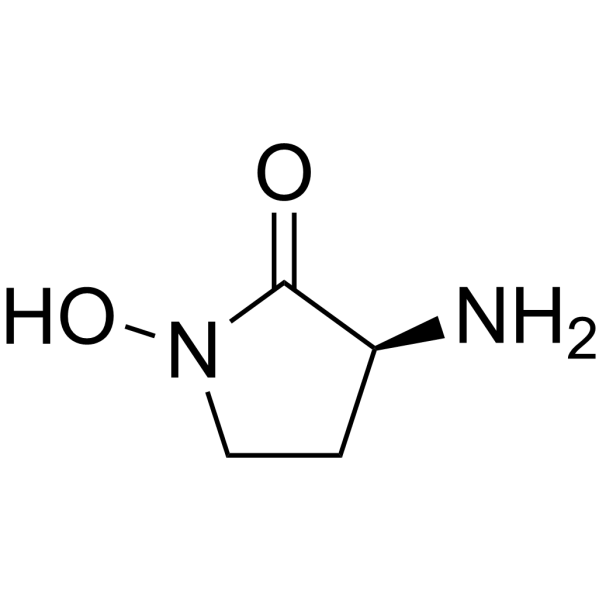
| 规格 | 价格 | |
|---|---|---|
| 500mg | ||
| 1g | ||
| Other Sizes |
| 靶点 |
NMDA Receptor
|
|---|---|
| 体外研究 (In Vitro) |
与 (-)-HA-966 (IC50=708 μM) 相比,(+)-HA-966 可抑制培养的皮质神经元上甘氨酸增强的 NMDA 反应,IC50=13 μM[2]。
|
| 体内研究 (In Vivo) |
(S)-(-)-HA 966 ((-)-HA 966;3 和 5 mg/kg;腹膜内注射) 在受到限制时抑制内侧前额皮质和伏核使用多巴胺。排便和不动是两种由恐惧引起的反应,可被 (S)-(-)-HA 966 抑制[1]。 (S)-(-)-HA 966(3 mg/kg;腹腔注射)抑制可卡因引起的急性运动反应,而不改变运动敏化过程[1]。尽管 (S)-(-)-HA 966(5 mg/kg;腹膜内注射)会导致嗜睡,但它会抑制可卡因引起的急性运动[1]。
|
| 酶活实验 |
(+/-)-3-氨基-1-羟基吡咯烷-2-酮(HA-966)对N-甲基-D-天冬氨酸(NMDA)受体的拮抗作用是通过与受体复合物中的甘氨酸调节位点选择性相互作用而发生的。当(+/-)-HA-966的对映体被解析时,发现(R)-(+)-对映体是一种选择性甘氨酸/NDA受体拮抗剂,这一特性解释了其在体内的抗惊厥活性。相比之下,(S)-(-)-对映体作为NMDA受体拮抗剂的活性较弱,但在体内仍具有明显的镇静和肌肉松弛作用。在放射性配体结合实验中,(+)-HA-966抑制士的宁不敏感[3H]甘氨酸与大鼠大脑皮层突触膜的结合,IC50为12.5微M,而(-)-HA-766的IC50值为339微M。在电生理实验中,(+)-HA-966选择性拮抗大鼠皮质切片中的NMDA受体反应,而(-)-对映体则弱得多。在培养的皮质神经元上,(+)-HA-966抑制甘氨酸增强NMDA反应,IC50=13微M,而(-)-HA-766的IC50=708微M。与外消旋HA-966的研究结果一致,即使是高浓度的(+)-HA-966也不能完全抑制NMDA反应,这表明(+)-HA-966是一种低效的部分激动剂。(+)-HA-966产生甘氨酸浓度曲线右侧的平行位移,以增强NMDA反应,导致估计的pKb=5.6。在小鼠中,(+)-HA-966拮抗了声音和N-甲基-DL-天冬氨酸(NMDLA)诱导的癫痫发作,ED50值分别为52.6mg/kg体重(i.p.)和900mg/kg(i.v.)。D-丝氨酸的联合给药呈剂量依赖性(每只小鼠脑室注射10-100微克)拮抗了次最大剂量的(+)-HA-966(直接脑室注射100微克)对NMDLA诱导的癫痫发作的抗惊厥作用。外消旋HA-966的镇静/共济失调作用主要归因于(-)-对映异构体,其效力是(+)-对异构体的25倍以上。有人认为,与镇静剂γ-丁内酯的情况一样,纹状体多巴胺能机制的破坏可能是这种作用的原因[2]。
|
| 动物实验 |
This report investigates the effect of the negative enantiomer of 1-hydroxy-3-aminopyrrolidone-2 (HA-966) on behavioral and biochemical changes elicited by pharmacological or experimental paradigms which activate mesocorticolimbic dopaminergic neurotransmission. Several paradigms were used, including cocaine sensitization and two stressors: restraint for 30 min and an aversive conditioning model. (S)-(-)-HA-966 (3 and 5 mg/kg i.p.) prevented restraint stress-induced dopamine utilization in both the medial prefrontal cortex and nucleus accumbens, in contrast to the positive enantiomer. Conditioned fear increased dopamine metabolism in both the core and shell subdivisions of the nucleus accumbens, an effect blocked by (S)-(-)-HA-966. The conditioned stress-induced increase in dopamine metabolism in the medial prefrontal cortex was also blocked by (S)-(-)-HA-966. In addition, (S)-(-)-HA-966 suppressed fear-induced behaviors: immobility and defecation. In other studies, (S)-(-)-HA-966 (3 mg/kg i.p.) prevented locomotor sensitization without altering the acute motoric response elicited by cocaine. The highest dose of (S)-(-)-HA-966 (5 mg/kg i.p.) blocked acute cocaine-induced locomotion but resulted in sedation. In addition, the highest dose of (S)-(-)-HA-966 tested suppressed weight gain in control rats, unlike its enantiomer, (R)-(+)-HA-966. Because (S)-(-)-HA-966 has been proposed to act at the gamma-aminobutyric acid (GABA)B receptor, we examined the ability of (S)-(-) and (R)-(+)-HA-966 to displace [3H]-(-)-baclofen from cortical membranes to assess GABAB receptor binding. Neither enantiomer significantly altered [3H]-(-)-baclofen binding at relevant concentrations, indicating the actions of (S)-(-)-HA-966 reported here are the results of a mechanism apparently independent of the baclofen binding site on the GABAB receptor[1].
|
| 参考文献 |
|
| 分子式 |
C4H8N2O2
|
|---|---|
| 分子量 |
117.12646
|
| 精确质量 |
116.059
|
| CAS号 |
111821-58-0
|
| 相关CAS号 |
42585-88-6 (HCl); 75195-65-2 (hydrate); 111821-58-0 (S-isomer); 123931-04-4 (R-isomer)
|
| PubChem CID |
183351
|
| 外观&性状 |
Typically exists as Off-white to light yellow solids at room temperature
|
| 密度 |
1.436 g/cm3
|
| 沸点 |
258.6ºC at 760 mmHg
|
| 闪点 |
110.2ºC
|
| LogP |
-1.5
|
| tPSA |
66.56
|
| 氢键供体(HBD)数目 |
2
|
| 氢键受体(HBA)数目 |
3
|
| 可旋转键数目(RBC) |
0
|
| 重原子数目 |
8
|
| 分子复杂度/Complexity |
115
|
| 定义原子立体中心数目 |
1
|
| SMILES |
[NH3+][C@H]1CCN(O)C1=O
|
| InChi Key |
HCKUBNLZMKAEIN-VKHMYHEASA-N
|
| InChi Code |
InChI=1S/C4H8N2O2/c5-3-1-2-6(8)4(3)7/h3,8H,1-2,5H2/t3-/m0/s1
|
| 化学名 |
(3S)-3-amino-1-hydroxypyrrolidin-2-one
|
| 别名 |
111821-58-0; (S)-(-)-HA-966; (S)-(-)-3-Amino-1-hydroxypyrrolidin-2-one; (3S)-3-amino-1-hydroxypyrrolidin-2-one; (S)-(-)-HA 966; HA-966, (S)-; (-)-HA 966; 2-Pyrrolidinone, 3-amino-1-hydroxy-, (S)-;
|
| HS Tariff Code |
2934.99.9001
|
| 存储方式 |
Powder -20°C 3 years 4°C 2 years In solvent -80°C 6 months -20°C 1 month |
| 运输条件 |
Room temperature (This product is stable at ambient temperature for a few days during ordinary shipping and time spent in Customs)
|
| 溶解度 (体外实验) |
May dissolve in DMSO (in most cases), if not, try other solvents such as H2O, Ethanol, or DMF with a minute amount of products to avoid loss of samples
|
|---|---|
| 溶解度 (体内实验) |
注意: 如下所列的是一些常用的体内动物实验溶解配方,主要用于溶解难溶或不溶于水的产品(水溶度<1 mg/mL)。 建议您先取少量样品进行尝试,如该配方可行,再根据实验需求增加样品量。
注射用配方
注射用配方1: DMSO : Tween 80: Saline = 10 : 5 : 85 (如: 100 μL DMSO → 50 μL Tween 80 → 850 μL Saline)(IP/IV/IM/SC等) *生理盐水/Saline的制备:将0.9g氯化钠/NaCl溶解在100 mL ddH ₂ O中,得到澄清溶液。 注射用配方 2: DMSO : PEG300 :Tween 80 : Saline = 10 : 40 : 5 : 45 (如: 100 μL DMSO → 400 μL PEG300 → 50 μL Tween 80 → 450 μL Saline) 注射用配方 3: DMSO : Corn oil = 10 : 90 (如: 100 μL DMSO → 900 μL Corn oil) 示例: 以注射用配方 3 (DMSO : Corn oil = 10 : 90) 为例说明, 如果要配制 1 mL 2.5 mg/mL的工作液, 您可以取 100 μL 25 mg/mL 澄清的 DMSO 储备液,加到 900 μL Corn oil/玉米油中, 混合均匀。 View More
注射用配方 4: DMSO : 20% SBE-β-CD in Saline = 10 : 90 [如:100 μL DMSO → 900 μL (20% SBE-β-CD in Saline)] 口服配方
口服配方 1: 悬浮于0.5% CMC Na (羧甲基纤维素钠) 口服配方 2: 悬浮于0.5% Carboxymethyl cellulose (羧甲基纤维素) 示例: 以口服配方 1 (悬浮于 0.5% CMC Na)为例说明, 如果要配制 100 mL 2.5 mg/mL 的工作液, 您可以先取0.5g CMC Na并将其溶解于100mL ddH2O中,得到0.5%CMC-Na澄清溶液;然后将250 mg待测化合物加到100 mL前述 0.5%CMC Na溶液中,得到悬浮液。 View More
口服配方 3: 溶解于 PEG400 (聚乙二醇400) 请根据您的实验动物和给药方式选择适当的溶解配方/方案: 1、请先配制澄清的储备液(如:用DMSO配置50 或 100 mg/mL母液(储备液)); 2、取适量母液,按从左到右的顺序依次添加助溶剂,澄清后再加入下一助溶剂。以 下列配方为例说明 (注意此配方只用于说明,并不一定代表此产品 的实际溶解配方): 10% DMSO → 40% PEG300 → 5% Tween-80 → 45% ddH2O (或 saline); 假设最终工作液的体积为 1 mL, 浓度为5 mg/mL: 取 100 μL 50 mg/mL 的澄清 DMSO 储备液加到 400 μL PEG300 中,混合均匀/澄清;向上述体系中加入50 μL Tween-80,混合均匀/澄清;然后继续加入450 μL ddH2O (或 saline)定容至 1 mL; 3、溶剂前显示的百分比是指该溶剂在最终溶液/工作液中的体积所占比例; 4、 如产品在配制过程中出现沉淀/析出,可通过加热(≤50℃)或超声的方式助溶; 5、为保证最佳实验结果,工作液请现配现用! 6、如不确定怎么将母液配置成体内动物实验的工作液,请查看说明书或联系我们; 7、 以上所有助溶剂都可在 Invivochem.cn网站购买。 |
| 制备储备液 | 1 mg | 5 mg | 10 mg | |
| 1 mM | 8.5375 mL | 42.6876 mL | 85.3752 mL | |
| 5 mM | 1.7075 mL | 8.5375 mL | 17.0750 mL | |
| 10 mM | 0.8538 mL | 4.2688 mL | 8.5375 mL |
1、根据实验需要选择合适的溶剂配制储备液 (母液):对于大多数产品,InvivoChem推荐用DMSO配置母液 (比如:5、10、20mM或者10、20、50 mg/mL浓度),个别水溶性高的产品可直接溶于水。产品在DMSO 、水或其他溶剂中的具体溶解度详见上”溶解度 (体外)”部分;
2、如果您找不到您想要的溶解度信息,或者很难将产品溶解在溶液中,请联系我们;
3、建议使用下列计算器进行相关计算(摩尔浓度计算器、稀释计算器、分子量计算器、重组计算器等);
4、母液配好之后,将其分装到常规用量,并储存在-20°C或-80°C,尽量减少反复冻融循环。
计算结果:
工作液浓度: mg/mL;
DMSO母液配制方法: mg 药物溶于 μL DMSO溶液(母液浓度 mg/mL)。如该浓度超过该批次药物DMSO溶解度,请首先与我们联系。
体内配方配制方法:取 μL DMSO母液,加入 μL PEG300,混匀澄清后加入μL Tween 80,混匀澄清后加入 μL ddH2O,混匀澄清。
(1) 请确保溶液澄清之后,再加入下一种溶剂 (助溶剂) 。可利用涡旋、超声或水浴加热等方法助溶;
(2) 一定要按顺序加入溶剂 (助溶剂) 。